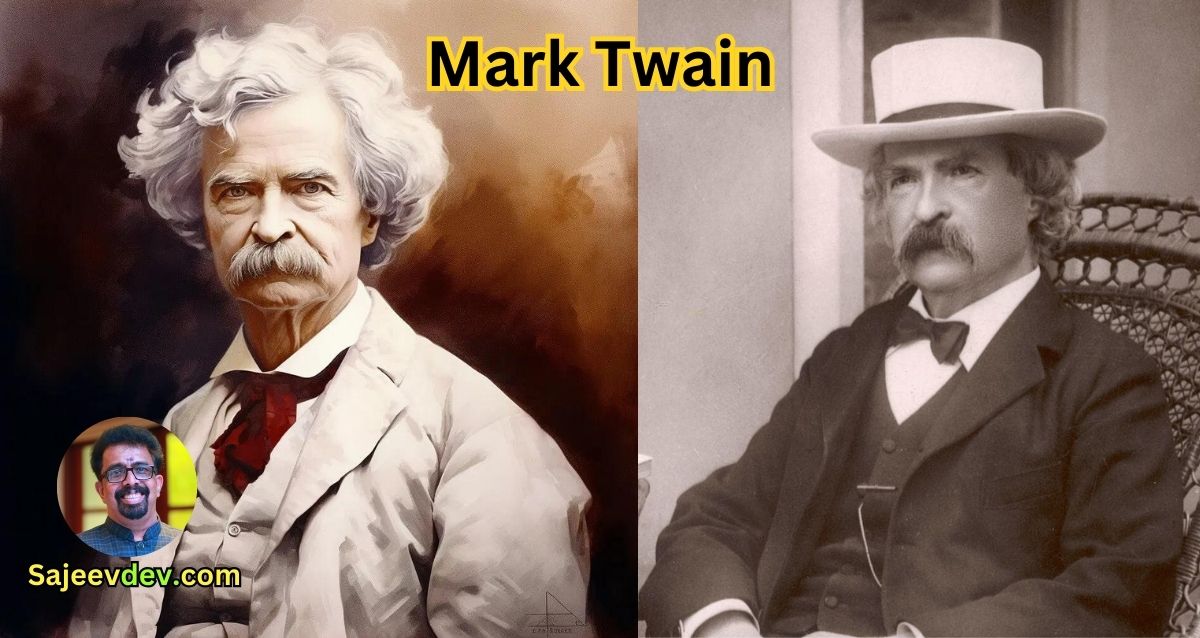Mark Twain
Born Samuel Langhorne Clemens on November 30, 1835, in Florida, Missouri, Mark Twain emerged as a towering figure in American literature. He passed away on April 21, 1910, but his legacy endures, solidifying his status as ‘the father of American literature’. Widely celebrated for his keen wit and satirical prowess, Twain made significant contributions as a writer, humorist, and social critic, shaping the American literary landscape in profound ways.
Twain’s writing is characterized by his astute observation of life along the Mississippi River and his critical perspective on societal norms and institutions. His classic works, such as “The Adventures of Tom Sawyer” and “Adventures of Huckleberry Finn,” have garnered acclaim for their rich, vivid storytelling and incisive commentary on themes such as slavery, freedom, and race. These narratives not only entertained readers but also incited thought and conversation on pressing social issues of his time.
In addition to his groundbreaking novels, Twain was also a prolific essayist and lecturer. His sharp humor and fearless criticism were evident in his public speaking engagements and numerous short stories and essays. Twain’s unique voice and insightful analyses of human nature and society have earned him a revered place in the canon of American literature.
Throughout his life, Twain’s work often reflected his experiences and observations, from his early years as a riverboat pilot on the Mississippi River to his later adventures worldwide. His keen ability to blend humor with social critique allowed him to connect with a broad audience, leaving an indelible mark on American culture.
Mark Twain revolutionized the literary world with a style that was distinctly American and profoundly impactful. His enduring influence on literature and society underscores his title as ‘the father of American literature,’ ensuring that his work will continue to be studied and celebrated for generations to come.
Early Life and Inspirations
Sam Clemens, later known as Mark Twain, was born in Florida, Missouri, on November 30, 1835. Growing up in the small town of Hannibal, situated along the Mississippi River, would deeply influence his literary works. Life along the river provided a tapestry of experiences from which he drew inspiration. The bustling steamboats, the charm of the riverbanks, and the diverse array of characters he encountered all fueled his vivid imagination and storytelling prowess.
Twain’s family faced significant financial hardships, shaping much of his early outlook on life. His father, John Marshall Clemens, struggled with consistent financial instability, attempting various ventures that mostly ended in failure. These economic difficulties imprinted on young Twain a keen awareness of the fragility and hardships of life, themes that frequently surfaced in his later works. Raffish characters and stories of survival against the odds became intrinsic to Twain’s narratives, reflecting his own experiences.
Educated formally only for a brief period, Twain’s schooling was cut short at the age of 11 following his father’s death. The responsibility to support his family forced him into various odd jobs. Despite this interruption, Twain’s real education came from life itself. Whether working as a printer’s apprentice or a riverboat pilot, each experience added layers to his understanding of human nature, society, and the world at large. These jobs exposed him to different walks of life, honing his keen observational skills and deepening his empathy for the common man’s plight.
Twain’s early adventures in Hannibal along with its colorful populace served as a bedrock for his celebrated works such as “The Adventures of Tom Sawyer” and “The Adventures of Huckleberry Finn.” These stories capture the spirit, struggles, and intricate dynamics of life during his formative years. Thus, Hannibal was not just a backdrop but a fundamental element that moulded Mark Twain’s distinctive voice in American literature.
Literary Beginnings
Mark Twain, born Samuel Langhorne Clemens, embarked on a journey characterized by a multitude of professions that would ultimately shape his literary career. His literary beginnings were influenced significantly by his early work where he started as a printer’s apprentice. This period provided him with not only a wealth of reading materials but also an understanding of the mechanics of writing and printing, sparking an interest that would last a lifetime.
Following his experience in the printing industry, Twain sought adventure and new perspectives, venturing into the life of a riverboat pilot on the Mississippi River. This role was instrumental, offering him a close-up view of the dynamics and culture of the American South. The river itself served as a backdrop for many of his literary works, becoming almost a character in its own right, filled with rhythmic life and vitality. The Mississippi River, with its serene but powerful presence, imbued Twain’s storytelling with a sense of place that was deeply intertwined with American identity.
Twain’s pursuits did not cease at the river’s edge. He took on various jobs, including a stint as a miner and later as a journalist. His time as a miner was marked by hardship and reflection, elements that would later enrich his narratives with authenticity and grit. Transitioning to journalism allowed Twain to hone his skills in observation and critique, crafting stories that captured the immediacy of everyday events while weaving in social commentary.
These diverse experiences collectively enriched Mark Twain’s literary voice, endowing him with a broad perspective and a rich tapestry of encounters and observations. His multifaceted career not only broadened his outlook but also deepened his understanding of human nature, setting the stage for his emergence as one of America’s most beloved literary figures. Each role he assumed contributed layers of depth and insight to his eventual body of work, making him the quintessential chronicler of the American experience.
The Adventures of Tom Sawyer
Published in 1876, The Adventures of Tom Sawyer is one of Mark Twain’s most celebrated works and a cornerstone of American literature. The novel revolves around the mischievous young protagonist, Tom Sawyer, who lives in the fictional town of St. Petersburg, Missouri, along the Mississippi River. Through a series of adventures and escapades, the story vividly captures the essence of boyhood in 19th-century America.
Tom’s character is emblematic of childhood innocence and the yearning for freedom. His adventures range from minor pranks, such as convincing his friends to whitewash a fence for him, to more serious endeavors, like witnessing a murder and searching for hidden treasure. These episodes are interwoven with themes of friendship, loyalty, and moral growth, making Tom Sawyer an enduring figure in literature.
The narrative also introduces unforgettable characters including Tom’s best friend, Huck Finn; his love interest, Becky Thatcher; and the enigmatic antagonist, Injun Joe. Huck Finn, in particular, embodies the spirit of rebellion and adventure, characteristics that have fascinated readers for generations.
The Adventures of Tom Sawyer goes beyond the mere recounting of childhood antics; it provides a snapshot of American life in the 19th century. Twain’s rich descriptions offer insights into the social norms, cultural practices, and dialects of the time, making the novel not just a literary piece but also an important social document.
The book’s enduring popularity can be attributed to its universal themes and relatable characters. It has influenced countless works in various media, from stage adaptations to films, cementing its status as a cultural icon. The playful yet poignant portrayal of youth resonates with readers of all ages, making The Adventures of Tom Sawyer a timeless fixture in American culture.
Major Works: Adventures of Huckleberry Finn
Published in 1884, Mark Twain’s Adventures of Huckleberry Finn is often hailed as the quintessential Great American Novel. Twain’s narrative style, characterized by the use of colloquial language and vivid regional dialects, brings authenticity and immediacy to the reader’s experience. The first-person perspective through the eyes of the young protagonist, Huck Finn, provides an intimate look at the complexities of American society in the pre-Civil War South.
At its core, Adventures of Huckleberry Finn is a profound exploration of race and identity. Through the evolving relationship between Huck and the runaway slave, Jim, Twain critiques the entrenched racial prejudices of the time. The novel challenges readers to confront the moral contradictions inherent in a society that values freedom yet systematically oppresses a significant portion of its population. Jim’s humanity and integrity stand in stark contrast to the hypocritical and often cruel behaviors of the other characters, emphasizing Twain’s social criticism.
The themes of friendship and moral dilemmas are pivotal to the narrative. Huck’s internal struggle with his conscience—whether to adhere to societal norms and turn Jim in or to follow his own moral compass and help him—reflects the broader conflict between societal expectations and personal integrity. This moral quandary elevates the novel from a mere adventure story to a profound social commentary.
Twain’s deft use of satire and humor further underscores the absurdities and injustices of the society he depicts. The novel’s episodic structure allows Twain to address a wide array of social issues, from the foolishness of feuding families to the incompetence of local authorities and the false piety of ostensibly religious individuals.
The significance of Adventures of Huckleberry Finn in American literature cannot be overstated. It is not only a critical reflection of its time but also a timeless work that continues to resonate with readers today. Its portrayal of friendship, moral dilemmas, and social criticism ensures its status as an enduring classic, offering deep insights into the American experience.
Twain’s Humor and Social Criticism
Mark Twain’s distinctive style of humor set him apart as a literary genius, intertwining wit and satire to critique societal norms, politics, and the very essence of human nature. His ability to infuse humor into serious discussions often disarmed readers, allowing him to tackle sensitive subjects such as racism, corruption, and inequality with an approachable demeanor. This unique blend of humor and social criticism has cemented his place as a pioneering figure in American literature.
One prime example of Twain’s satirical prowess is his acclaimed novel “The Adventures of Huckleberry Finn.” Through the innocent eyes of Huck, Twain delves into the absurdity and immorality of slavery and deeply ingrained prejudices. By adopting a seemingly naive perspective, he exposes the irrationality and cruelty of racism, prompting readers to confront these uncomfortable truths in a less confrontational manner.
Another significant work, “The Gilded Age: A Tale of Today,” co-authored with Charles Dudley Warner, critiques the rampant corruption and greed prevalent in post-Civil War America. The term “Gilded Age,” coined by the authors, remains synonymous with the era’s ostentatious displays of wealth and deep-seated corruption. Through satirical depictions of politicians and businessmen, Twain underscored the disparities between America’s lofty ideals and the stark realities of its socio-political landscape.
Twain’s short story “The Man That Corrupted Hadleyburg” illustrates his keen insight into human nature and morality. By depicting a seemingly upright town exposed as hypocritical and morally bankrupt, he critiques the facade of righteousness often upheld in society. Twain’s sharp, humorous narrative not only entertains but also invites readers to reflect on the inherent flaws and contradictions within societal values.
In works such as these, Twain masterfully employed humor to provoke thought and foster discussion on pressing social issues. His legacy as a humorist and social critic endures, reminding us of literature’s power to both entertain and enlighten, urging society to confront its darker aspects and strive for progress.
Personal Life and Challenges
Mark Twain, born Samuel Langhorne Clemens, was intricately shaped by his personal life experiences and the challenges he encountered. Twain’s marriage to Olivia Langdon in 1870 marked a significant phase in his life. Olivia, often referred to as Livy, was not only his wife but a critical influence who provided intellectual camaraderie and emotional support. The couple had four children: Langdon, Susy, Clara, and Jean. Sadly, the Clemens family endured the tragic loss of Langdon in infancy, Susy at 24, and Jean at 29, each leaving indelible marks on Twain’s emotional state and writings. These personal sorrows are often reflected in the melancholic tones found in Twain’s later works.
Financially, Twain faced numerous hurdles throughout his life. In pursuit of wealth beyond his earnings from literature, he made several ill-fated investments. Notably, his investment in the Paige Compositor, a typesetting machine, ended disastrously, consuming a significant portion of his finances without yielding expected returns. Consequently, Twain faced bankruptcy and significant debt, yet these aspects of his life did not only spell despair but served to fuel his creative process. His financial struggles inspired some of his work, bringing a nuanced realism and critical perspective to his narratives.
Adding to his repertoire of coping mechanisms, Twain embarked on extensive travels and lecture tours. These journeys provided much-needed solace and served as sources of inspiration. Whether it was Lambeth Palace in London or the beguiling temples of India, Twain’s wanderlust found its way into his storytelling, enriching it with global flavors and observations. The lecture tours, although primarily intended to recoup financial losses, allowed Twain to connect with diverse audiences, reinforcing his role as a master storyteller.
Thus, Mark Twain’s personal life’s tapestry, woven with familial love, loss, financial turmoil, and global exploration, profoundly influenced his literary legacy. These facets provided depth and authenticity to his portrayal of the human condition, securing his place as a pivotal figure in American literature.
Legacy and Impact
Mark Twain, often heralded as the Father of American Literature, fundamentally shaped the landscape of both literature and cultural identity in the United States. His works, characterized by their sharp wit and profound social commentary, have left an enduring legacy that continues to captivate and influence readers around the world. Twain’s pioneering use of vernacular speech in his characters helped to create authentic American voices, which resonate deeply with the socio-political climate of his era and beyond. His most celebrated novels, such as “The Adventures of Huckleberry Finn” and “The Adventures of Tom Sawyer,” remain cornerstone pieces in the study of American literature.
Twain’s influence extends beyond the printed page. He has inspired countless generations of writers who view him as a literary trailblazer, opening new avenues for narrative style and thematic exploration. Prominent authors, ranging from Ernest Hemingway to J.D. Salinger, have acknowledged Twain’s profound impact on their own works. Moreover, Twain’s storytelling prowess has transcended literature, permeating various forms of media, including adaptations in theatre, film, and television, thereby ensuring that his stories continue to engage and inspire diverse audiences.
Commemorations of Mark Twain’s enduring legacy abound. Landmarks and institutions in his honor are spread across the United States, with the Mark Twain House & Museum in Hartford, Connecticut, serving as a prominent example. Here, visitors can delve into the life and times of Twain, gaining insight into his creative process and the historical context of his works. Additionally, numerous schools, towns, and libraries bear his name, further cementing his standing as an iconic figure in American culture.
Today, the timeless themes explored in Twain’s works, such as the quest for freedom, the critique of societal norms, and the complexity of the human condition, continue to resonate with contemporary readers. His ability to blend humor with poignant social critique keeps his narratives both relevant and compelling. As a result, Mark Twain’s contributions have not only shaped America’s literary canon but have also profoundly influenced its cultural identity, securing his place as a pivotal figure in the annals of American history.









